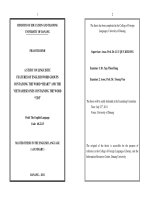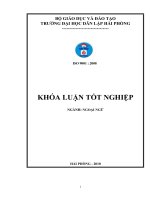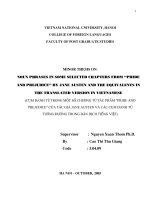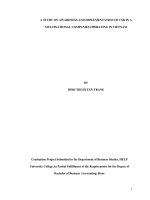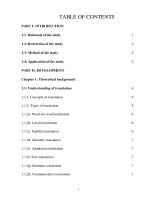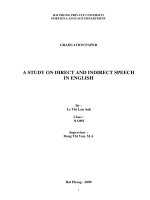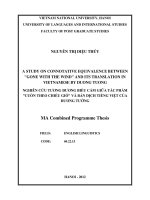a study on historical and social background and the newness of language use in pride and prejudice by jane austen = nghiên cứu cơ sở lịch sử, xã hội và tính mới của việc sử dụng ngôn ngữ trong tác phẩm
Bạn đang xem bản rút gọn của tài liệu. Xem và tải ngay bản đầy đủ của tài liệu tại đây (1.04 MB, 61 trang )
VIETNAM NATIONAL UNIVERSITY, HANOI
Hanoi University of Languages and International Studies
Faculty of Post-graduate studies
****************
NGUYỄN KIM OANH
A Minor thesis on:
A STUDY ON HISTORICAL AND SOCIAL
BACKGROUND AND THE NEWNESS OF
LANGUAGE USE IN ‘PRIDE AND PREJUDICE’
BY JANE AUSTEN
(NGHIÊN CỨU CƠ SỞ LỊCH SỬ, XÃ HỘI VÀ TÍNH MỚI CỦA
VIỆC SỬ DỤNG NGÔN NGỮ TRONG TÁC PHẨM „KIÊU
HÃNH VÀ ĐỊNH KIẾN‟ CỦA JANE AUSTEN)
Field: Linguistics
Code: 602215
HANOI – DECEMBER 2012
VIETNAM NATIONAL UNIVERSITY, HANOI
Hanoi University of Languages and International Studies
Faculty of Post-graduate studies
****************
NGUYỄN KIM OANH
A Minor thesis on:
A STUDY ON HISTORICAL AND SOCIAL
BACKGROUND AND THE NEWNESS OF
LANGUAGE USE IN ‘PRIDE AND PREJUDICE’
BY JANE AUSTEN
(NGHIÊN CỨU CƠ SỞ LỊCH SỬ, XÃ HỘI VÀ TÍNH MỚI CỦA
VIỆC SỬ DỤNG NGÔN NGỮ TRONG TÁC PHẨM „KIÊU
HÃNH VÀ ĐỊNH KIẾN‟ CỦA JANE AUSTEN)
Field: Linguistics
Code: 602215
Supervisor: Dr. Phạm Đăng Bình
HANOI – DECEMBER 2012
iii
TABLE OF CONTENTS
Page
Acknowledgement i
Abstract ii
Table of contents iii
PART 1: INTRODUCTION
1. Rationale of the study 1
2. Aims and objectives of the study 2
3. Methodology of procedures 3
3. 1. Design of the study 3
3. 2. Data collection and date analysis 3
4. Scope of the study 4
PART 2: DEVELOPMENT
CHAPTER 1. THEORETICAL BACKGROUND
1.1. Definitions of key terms 5
1.1.1. Discourse and discourse analysis 5
1.1.2. Literary style 9
1.1.2.1. Word choice 10
1.1.2.2. Sentence fluency 10
1.1.2.3. Voice 10
1.1.3. Language use 11
iv
1.1.3.1. Participant 12
1.1.3.2. Social processes 12
1.1.3.3. Collective activities 12
1.2. Previous studies 13
CHAPTER 2. ANALYTICAL BACKGROUND
2.1. Introduction to Jane Austen 14
2.2. Introduction to „Pride and Prejudice‟ 15
2.2.1. Summary 15
2.2.2. Themes 16
CHAPTER 3: HISTORICAL AND SOCIAL BACKGROUND OF BRITISH
NOVELS
3.1. Historical background 17
3.2. Social background 19
3.3. Themes and forms of the late 18
th
and early 19
th
century novels 19
CHAPTER 4: NEWNESS OF LANGUAGE USE IN ‘PRIDE AND
PREJUDICE’
4.1. Austen‟s distinctive writing style 23
4.2. Newness in language use 24
4.2.1. Language use in the three leading conversations 24
4.2.1.1. Act 1 25
4.2.1.2. Act 2 30
v
4.2.1.3. Act 3 36
PART 5: CONCLUSION
1. Newness of language use 37
2. The matter of love and love expressing 39
3. Contributions of the study 40
4. Suggestions for further studies 40
REFERENCES ……………………………. 41
APPENDIX I
1
PART 1: INTRODUCTION
This initial part stated the problem and the rationale of the study, together with the
aims, objectives, the scope of the study, and the overview of the rest of this
research paper. Above all, it was in this part that the research question was
identified to work as clear guidelines for the whole research.
1. Rationale of the study
In the eighteenth century, the readers were delighted by a new form of prose,
which was called „novel‟ for the first time by Daniel Defoe – the first considerable
British novelist. A „novel‟ with a certain length did bring amusement, pleasure and
joy to those who were concerned when the contemporary British society was
dreadfully chaotic in the virtue of the changes in the monarch. In the innovation of
this new form of prose, there appeared a remarkable number of writers and their
works. They were coined to emphasize not only the social changes but also the
imaginary stories, which exposed their hope for a better life, so even the family or
social class problems were best put down in words by one of the most famous
female novelist in Britain and all over the world – Jane Austen.
Peter Washington in his commentary once implied that Jane Austen belonged to
the fantastic side of the English comedy that appealed so strongly to the readers,
not only in Britain but also from all over the world.
She was also said to be the first novelist capable of “conveying both interior and
exterior of human life” as well as “developing the means of representing the
totality of human life” (Ian Watt, 1957)
In the six novels written during the very last decades of the eighteenth century, she
truly succeeded in describing “the involvements and feelings and characters of
ordinary life which to me the most wonderful I‟ve ever met with … that a pity such
a gifted creature dies so early” as Walter Scott (1826) once stated in his
2
commentary. All the certain circumstances were just within the leading
involvement of one family and their neighbours and friends in which Austen
created “some heroines who were credible with minds, with the capacity to think
for themselves with ambition and wit”; and „Pride and Prejudice‟, the novel about
marriage, was said to be the best of them all.
„Pride and Prejudice‟ was coined to construct the frame of the contemporarily
social satire, within the relationship between people from the middle and upper
classes. It initially commenced the era of „country family novels‟ which set a
“prying inquiry into the manner, human dignity and great strain” on the
characters and the society they were living in, which made her novels connected to
the contemporary world more than the traditional society of the eighteenth
century as Diệp Minh Tâm (2002) once commented.
Further more, it ranked one of the greatest novels of all time following “Wuthering
heights” by Emily Bronte - 1847) and was read even if it was not taught at school.
The researcher was impressed by the name of the novel at first and became
overexcited about the novel since she finished reading it for the first time. The
novel was really linked to both of the real world and the emotional changes inside
individuals, especially the female. Therefore, putting extra effort in investigating
what impressed her really fed her desire to understand the people and society at
the time.
2. Aims of the study
This study was carried out with the hope of exploring the background of the
temporary Britain leading to the remarkable changes in its literal history of the
eighteenth and nineteenth centuries especially in the view on British novels.
The study also aimed at answering the question: “What is Jane Austen‟s
distinctive writing style?”. The answer to the question would help the students of
Linguistics, the novel's readers as well as those who wished to specialize in
3
English Literature realize what made Austen one of the most successful female
novelist of the century.
Right from the start, the researcher expected to find out the historical and social
background of the British Literature and briefly analyze the language use in „Pride
and Prejudice‟ which exposed Austen‟s distinctive writing style.
Last but not least was the researcher‟s desire to understand the novel, which was
really related to the controversial matter of love and love expressing.
3. Methodology of procedures
3.1. Design of the study
The study was divided into three main parts. While Part One dealt with the general
information which contained the rationale, aims and objectives, methodology and
scope of the study, Part Two went into further details of the historical and social
background; and the newness of language use in Jane Austen‟s Pride and
Prejudice through four chapters. The suggestions for further research would not be
omitted in the last part.
3.2. Data collection and data analysis
The study used the descriptive and contextual methods of data collecting and
analyzing.
Basing on the huge resources of library and internet materials, the researcher
analyzed and then agglutinated those ideas into her own brief clear and
understandable viewpoints.
On the other hand, several differences in the changeable literal trends of the
eighteenth and nineteenth centuries would be briefly stated in her Analysis on how
main characters exposed their own „pride‟ and „prejudice‟ in some certain
circumstances through the three volumes.
4
4. Scope of the study
As could be seen from the title, the study strongly focused not only on the
historical and social background but also on the language use of the novel which
played the most important role.
To understand that newness of language use in the novel, the researcher had to pay
her full attention to the main characters‟ leading conversations in the three
volumes which helped expose the cherish love and the theory of „pride‟ and
„prejudice‟ – the main themes of the novel. Amongst the three conversations, the
first two would be thoroughly analyzed, for the reason that the first „conversation‟
brought the two main characters by their mistaken first impression and the second
conversation was about the conflicts finally resolved.
5
PART 2: DEVELOPMENT
CHAPTER 1. THEORETICAL BACKGROUND
1. Definitions of key terms
To be able to analyze the newness of language use through the three acts of the
novel, there were several key terms: discourse and discourse analysis, literary style
and language use, which needed to be deeply understood. So for the purpose of
providing a clear and deep understanding of the matter, this first chapter would
focus on the definitions of those key terms while mentioning some necessary
information about previous studies that related to the matter of the study.
1.1. Discourse and discourse analysis
Through centuries, 'discourse' was defined in various ways by a number of
scholars.
„Discourse‟ was 'stretches of language perceived to be meaningful, unified and
purposive'. (Cook 1989:156)
„Discourse‟ was considered 'a communicative event which draws on the meaning
potential of the language (and other systems of communication) to carry
communicative value (the illocutionary force) of speech acts through utterances.
In other words, it referred to “the interpretation of communicative events in
context.” (Nunan 1993:7-8)
It could be said that there were no significant differences between those definitions
since the notion of „discourse‟ was all about how the language use was understood
in such verbal events.
Sharing a lot in common with Malinowski, linguists (Hymes, 1960s; Austin, 1962;
Searle, 1969; Grice, 1975; and Halliday and Hasan, 1973, 1978, 1989, 1994) had
6
drawn certain attention to this branch by clarifying some “contextual, grammar
and cohesional models as well as pragmatic and conversational viewpoints”.
However, at the limitation of the minor thesis, the researcher wanted to focus on
the role of contextual analysis in the three major discourses for the reason that
'context' was created by the discourse and vice versa. It was what and how people
could depend on to interpret the discourses created in each context as Nunan
(1993:7-8) cited that J.R. Firth and Dell Hymes also appreciated the idea that
people always reacted toward how they understood and predicted what the others
were going to say next.
More systematically, Halliday (1989) developed a model of contextual analysis,
just following the context of situation, which included three components as
followed:
Components of a
SITUATION
Feature of the context
Field of discourse
what was happening, to the nature of the social action
that was taking place
Tenor of discourse
Who were taking part in the situation
Mode of discourse
The role assigned to language
7
Example 1:
A short conversation was given and analysed in Halliday and Hasan‟s theory
(1989) as an example:
Doctor: Have you been vomiting?
Patient: Em, yeah. I vomitted about … I vomitted twice … two days ago at school
and I vomitted about um eight or ten times last night.
Patient: Oh, er, just sort of altogether, you know, Dr M gave him anti-biotic
capsules for him to take because he's also got …
Doctor: a throat.
Patient: A bit of infected tonsils yeah and he said that, you know for him to spit
the capsule out … I don't know whether he was trying to swallow it down or what
but he did.
Doctor: Ah Look, I don't think you can go past an appendix there. Just, you know,
number one, he's got no pain just there and is sore there and I think he's probably
got something blocking in the appendix and it's giving him this constant pain and
trouble. So seeing that you've had it for some time and been worse lately I think it
certainly would be wise to think about having done.
(Halliday and Hasan,1989)
8
Analysis of Example 1
Components of a
SITUATION
Feature of the context
Field
A child-patient that influenced the choice of lexical items
Tenor
A doctor and a patient
Mode
The choice of lexical items: parts of the body: throat, tonsil,
appendix; bodily actions: vomit, spit, swallow
Example 2
A: Hi! I didn't know you belonged to the national Film Theatre. Have you been a
member for long?
B: No, I joined only last week. It's good, isn't it?
A: Yes, it is. There's always an excellent selection of films here. I'm just going to
get a coffee. Would you like one?
B: I'm really thirsty. Oh, don't forget that I've given up sugar.
(Hoang Van Van Ph.D, 2006)
Analysis of Example 2
Components of a
SITUATION
Feature of the context
Field
An informal conversation between friends in a cafeteria
Tenor
Two friends
Mode
Use of words related to theatre: film, member; cafeteria:
thirsty, coffee, sugar
9
In the field of Literature, no matter what the story was, the conversations might be
between or amongst people in a certain circumstance, but it was Mode that
perfectly helped recognize and distinguish an author's literary style from others'.
1.2. Literary style
Literary style was defined in various ways by a number of scholars.
According to Geoffrey Leech and Mick Short, Literary style referred to “linguistic
choice in general” or to “those aspects of linguistic choice which concern
alternative ways of rendering the same subject matter” (cited by Mitchell, A. &
McGee, K. 2011: 31-32).
Much more clearly in “Linguistics and literary style” (1970), Donald C. Freeman
once clarified the literary style into some categories: sentence structure, pace,
vocabulary, figures of speech, use of dialogue, tone, etc.
Similarly with those scholars, David Watson in „The Elements of Style‟ (1915),
defined literary style as “the translation of thought into language”. This
identification of the style surely did not fail in “width and generality”. In other
words, there was no doubt, as the widespread belief in the existence and the power
of something so called when words, sentences and voice were carefully chosen to
be the means or the medium of the garment of the certain processes of thought. It
gave a distinction to certain writers or compositions because even though it was
not so easy to recognize an author‟s style, readers were still able to see her literary
accent of a school, a nation or an age which could be clarified through the concrete
whole form by means of a number of concrete parts.
Although literary style was defined in various ways, it was known in conclusion as
the element that described an author‟s choice of words, sentence structures,
figurative language and the habit of correct grammar, arrangement of all her work
together to establish mood, images and meaning of the text. In the limitation of
10
this minor study, the researcher would focus on three main elements, which were
known in the necessity of Mode in Halliday‟s theory, as David Watson (1915) and
Strunk W. and White E.D. (2000) once again agreed.
1.2.1. Word choice
General speaking, nouns and verbs were the main medium, which helped readers
visualize and convey the meanings of a novel, and a novel writer was said to be
good only if she knew when to choose or weed out the words concisely and
precisely. It should be words which were “active verbs, concrete nouns and
specific adjectives” (cited in „The Elements of Style‟, 2000).
1.2.2. Sentence fluency
Easily seen in well-known novels that readers mostly were attracted by a variety
of sentences with different lengths and rhythms which was called “the flow and
rhythm of phrases and sentences”; in other words, it was „Sentence fluency‟. All
the ideas were carefully considered, chosen and then arranged in various structures
to reflect the main themes of the novel. They were not like in speaking when
people could not rethink or revise the ideas for effect. To make the sentences
fluent, sounding like an own style, the writer would re-choose the words, delete
redundancies, make vague or ambiguous words much clearer to convey the
greatest effect as possible.
1.2.3. Voice
There was an old saying: “Style is the dress of thoughts”; and literary style was
most clearly defined by an author‟s voice. Although voice was difficult to be
drastically measured, it was the essential element that revealed the writer‟s
personality to the extreme; and in „Pride and Prejudice‟, Jane Austen was
successful in portraying characters with a great sense of irony.
11
“Irony is a form of utterance that postulated a double audience, consisting of one
party that hearing shall hear and shall not understand, and another party that,
when more is meant than meets the ear, is aware both of that more and of the
outsiders‟ comprehension” (Fowler, 1968 – cited in “Irony” by Colebrook, 2004)
In those hidden language, actions, differences and communications, irony was
seen as an art or a means of worth and effective persuasion in speeches when it
allowed people to convey the meaning above what was said. As Socrates (cited by
Colebrook, 2004) once implied, irony was used by saying one thing and meaning
another which resulted in an insistence. Irony was believed to bring about “truth
and recognition” even if that truth was hard to be recognized and not fully
meaningful.
1.3. Language use
Language use was said to be “the people‟s production and understanding of a set
of sentences with particular meanings” (cited in “Irony” by Colebrook, 2004). In
other words, the choice of words had to be suitable for each communication
circumstance so as to express different meanings, those needed to be clarified and
deeply understood in order to keep up with the chains of following activities. In
those activities the speakers said and took actions by using words whilst the others
had to coordinate with them in trying to comprehend what they meant.
In fact, the term “language use” received a certain attention from literary scholars,
but more clearly and closer to Halliday‟s theory that the researcher based on when
analyzing the discourses, Clark (2000) developed the theory by Gumperz and
Hymes (1964, 1972) and once acknowledged that the speakers‟ word and sentence
meaning came first in theories of language structure. That was the reason for his
further study in the use of words and sentences in his “Arenas of Language use”.
According to him, the meaning would be clearly recognized through the properties
12
of the three certain arenas: 1. Participants 2. Social processes 3. Collective
activities.
1.3.1. Participants
The participants were the speakers and the speakers‟ attendants – the addressees -
and certain so-called participants in the actions. They had certain additional roles –
depending on each situation – that helped define what the speakers said and meant.
In conversations, they were speakers and listeners.
1.3.2. Social processes
The language that was used should be depended on what the social processes
were. For instance, in the relationship between Darcy and Elizabeth, they used the
language, which fit their social attitude towards the other even when the first
impression might be wrong. They spoke to the other in an ironic manner and voice
due to the awareness of their own „pride‟ and „prejudice‟ toward the social status.
The novel ended when they both came to expose love to each other despite the
social differences.
1.3.3. Collective activities
Three main acts of the novel included a number of activities that brought the
characters to take part in and to accomplish the social processes. People spoke and
listened to one another in collaboration and in coordination as to bridge the
communication gap and to reach the goal revealed at the end of the novel.
Even though the language use was seen from various viewpoints, there was no
doubt that they had some similarities in the use and choice of words and sentence
structures, which were so typical for each character in different contexts.
1.2 Previous studies
13
Through centuries, not only the content but also the literary style in „Pride and
prejudice‟ was discussed a thousand times by a big number of scholars from all
over the world. However, several ambiguous and contradictory viewpoints began
to be discovered in the process of analyzing the novel such as Tory or
Enlightenment feminism, individual society, etc. By synthesizing the related
studies, several ideas were recognized and considered some typical features, which
helped exposing Jane Austen‟s distinctive writing style under the English society
in the late eighteenth and early nineteenth centuries.
In „Pride and Prejudice‟ which ranked second on the list of the greatest love story
of all time, Jane Austen was successful in portraying the contemporary English
society with satires when people could not easily and freely express themselves
towards others due to the class differences. She was not only proved as the one
who recognized a tradition of thought that “women were treated as an inferior
class in a man‟s world” – Bulter once argued but also the one who appreciated the
essential role of a female with “dutifulness, meditativeness, self-abnegation and
self-control” – Mary Brunton said. After all, that was why they intended to turn
out their „pride‟ and „prejudice‟ against each other when they had something to be
proud of (cited in Women‟s whole Existence by Birgitta Berglund, 1993).
14
CHAPTER 2. ANALYTICAL BACKGROUND
2.1. Introduction to Jane Austen
Born on the sixteenth of December, 1775 in Steventon, Hampshire, England, Jane
Austen was the seventh of the clergyman George Austen‟s children and shared the
most intimate relationship with her sister Cassandra who had never got married.
Jane Austen was in possession of a great desire in reading from her father – a
rector who lived an uneventful life at the birthplace but always encouraged his
daughters to read passionately as much as they could. Not only Jane but other
Austen children from time to time presented short plays watched by the family and
neighbours for entertainment, which helped create the warm and friendly living
environment and the close relationship amongst family members, which helped
generate her writing ability as well as give her the ideas for the later works.
At the age of eleven, she started writing her very first parodies of popular
literature for the entertainment of her family. In those short proses, „swooning and
blushing heroines, noble heroes and melodramatic plot or courtship‟ were quite
clearly exposed.
(Pride and Prejudice,1993)
From then on, she spent more of her awareness and effort in the field of literature.
Some full-length novels were written at her age of twenty; however, they were
kept a secret from her family who soon became her ardent supporters and played a
very important role in her future writing. She stumbled over her first handling
novels to the press for the first time when she completed her „Sense and
sensibility‟ in 1795 and „Pride and prejudice‟ in 1797. Even though Jane was
desperate due to the rejection of those two novels, she got back on and rewrote
them, which were then published and widely known by various readers.
Jane Austen once felt in love, when she was twenty-six, with a young clergyman
15
who suddenly died without any reasons; and once agreed to marry a wealthy man
but they broke off the engagement in the following day. It was so understandable
that all of her novels were about courtship and marriage. Not only did they
mention the society, which had very narrow and rigid expectations for women but
also sharply drew a significant picture of the relationship between men and women
of her contemporary time.
Living from 1775 to 1817, at the age of forty two, she died and left her legacy of
six novels which were written in a slightly different orders but completed and
published as followed: Sense and Sensibility (1811), Pride and Prejudice (1813),
Mansfield Park (1814), Emma (1816) and Northanger Abbey and Persuasion
(1818 – one year after her death).
Amongst her six novels as stated above that „Pride and Prejudice‟ was highly
appreciated and got the greatest care from the scholars and readers. This novel was
first written in 1796, then entitled „First Impressions‟.
2.2. Introduction to 'Pride and Prejudice'
2.2.1. Summary
Mr and Mrs Bennet lived their uneventful life with five daughters at Longbourn in
Herfordshire. In the absence of a male heir, their property would pass by entail to
a cousin, William Collins who lately came to the town, aiming to marry a fine
woman in the neighbourhood. The story really started when Elizabeth and four
other sisters – Mr and Mrs Bennet‟s daughters – were wanted to go to the
welcome ball of Mr Bingley – a new single rich bachelor coming to the
neighbourhood, together with his two sisters and friend – Fitzwilliam Darcy. Mrs
Bennet – a miraculously tiresome mother - was consumed by the desire to see her
daughters married and seemed to care for nothing else in the world because she
believed: “It is a truth universally acknowledged that a single man in possession
16
of a good fortune must be in want of wife”. This ball brought Bingley and Jane –
the eldest Bennet girl – together through an actual attraction, and Elizabeth‟s „first
impression‟ toward Mr Darcy - “the proudest, most disagreeable man in the
world” who would never be welcomed again in Longbourn. Furthermore, he was
one of the two – with Mr Bingley‟s sister – adding intensified aversion to the
separation of Bingley and Jane later on.
Meanwhile Mr Collins got a marriage refusal when he proposed to Elizabeth.
Promptly he transferred his affection to Charlotte Lucas which was finally
accepted. Elizabeth once again was brought into a contact with Darcy in
Pemberley, in Derbyshire where Darcy proposed to her in terms that did not
conceal his pride but got an indignant rejection back. During this visit, Elizabeth
reached the news that her sister Lydia eloped with Wickham, son of the steward of
the Darcy property. The story was untied since Darcy‟s letter to Elizabeth and they
finally engaged, back to Longbourn and the relationship between Bingley and Jane
was also renewed, and then ended in a happy engagement.
2.2.2. Themes
The short courtship between Darcy and Elizabeth was an example of “one of the
most cherished love stories” (Spark notes, 2012) in the English literature which
displayed the „Pride‟ and „Prejudice‟ even when their love and marriage was built
and maintained through their common interests in reading. Elizabeth, who even
did not have a home-tutor, had a great desire in reading books while Darcy
exposed his reading interest in preserving his father‟s big library in the house,
revealed during Elizabeth‟s stay in Pemberley and led to the readers‟ realization of
a suitable match – Darcy and Elizabeth.
While other four couples‟ which were presented in the novel: “to the love and
attraction shared by Jane and Mr Bingley; the convenience of marriage was
portrayed through Charlotte and Mr Collins; Lydia and Wickham‟s marriage was
17
based on their desire, attractions and financial status; Mr and Mrs Bennet‟s
marriage was for their necessity; the love of Darcy and Elizabeth was so pure”,
( unlike the others‟,
and then was recognized through a number of their many countless small
obstacles. Being portrayed as a very proud man, Darcy was misjudged by the first
poor expression in Elizabeth blinding herself for quite a long time. To the surprise
that Darcy, who would find hard to express his own love feeling to others
especially a woman in this case, decided to express his love to Elizabeth by saying
such a pure and genuine sentence: “You must allow me to tell you how much I
admire and love you” (p157). Elizabeth‟s love for Darcy was very clear when she
said to her parents “I do like him, I love him”. The „pride‟ and „prejudice‟ towards
each other seemed no longer exist between them at the very end of the novel when
both of the two main characters said for their love and belief in the future good
marriage. The love between these two individuals was truly depicted to be
something independent of all invisible social forces.
Jane Austen surely had a number of her reasons to re-title the novel by „Pride and
Prejudice‟ instead of „First Impression‟ as she did. ‘Pride’ and ‘Prejudice’ played
as the two other main themes which people living in the current time found
difficult to understand the meaning. As mentioned in the novel that people of
whatever the society was could be prevented from realizing the truth due to their
own pride and prejudice towards other people. Walter Scott (cited by Qaisar Iqbal
Janjua, 2010) once commented: “In Pride and prejudice one cannot equate Darcy
with Pride, or Elizabeth with Prejudice; Darcy‟s pride of place is founded on
social prejudice, while Elizabeth‟s initial prejudice against him is rooted in pride
of her own quick perceptions”. It meant that people were unable to separate and to
analyze only Pride but Prejudice in Darcy or Elizabeth and vice versa, which
would be more deeply and clearly analyzed in the following part of the study.
18
CHAPTER 3: HISTORICAL AND SOCIAL BACKGROUND OF BRITISH
NOVELS
3.1. Historical background
British history was said to be different from that of the European Continent
because there had been no civil war in the country for centuries. The British Isles
had been inhabited by human beings for some 250,000 years, its history might
appropriately begin with the Celts, who crossed from the European continent and
settled in the British Isles (England, Scotland, Wales and Ireland) during the very
first millennium B.C.
Those thousands of years had passed and the country had been through many
significant changes. During the Medieval Era, Anglo-Saxon‟s conquest and then
Roman‟s first invasion ruined the country, which finally recovered until the Age
of Elizabeth I. It was once again known as the age of the prosperity with economic
and political stabilities.
Under Elizabeth I's control, the greatest age of British Literature was significantly
marked by the first long story „Le Brut‟ – a story about King Arthur - by Wace
was considered the very first accomplishment in literature, and Elizabethan
homilies, which were to highlight the important of peace, unity and regulations
obedience. This glorious time of British literature was seen in the rise of comedies
and tragedies in theatre by one of the most popular author – William Shakespeare:
Othello – domestic tragedy as the jealousy rose to ruin the family members‟
relationships while Macbeth – poetic tragedy as the people were drawn in
disappointment and guiltiness. Additionally, the very first step to British novels
was made to the publishing of „Pandosto‟ by Robert Green in 1588, „Jack of
Newbury‟ by Thomas Deloney in 1597 and „The Unfortunate Traveller‟ by
Thomas Nashe in 1594.
19
3.2. Social background
British society, with its class system and different class beliefs also provided a rich
source of materials for character-based novels. Many of them depended on the
contrasts, real and imagined, between people of different classes, most especially
the contrast between the middle and upper class families those who were different
mainly in social status and fortune. On the contrary, to the middle class, who was
able to partially afford their own demands, the upper class was of a very good
fortune, a plenty of fertile lands & ten thousand pounds per year. Those were seen
as the upper class who received a deep mutual respect and care from the rest of the
society and novels were coined to fulfill the mission of describing the differences
and conflicts.
The Age of Elizabeth I was considered the greatest age of English Literature due
to the appearance of many types of literary work including: poetry, comedy/
tragedy in theater, narrative and a very first step to novels at the late sixteenth or
early seventeenth century. Besides, Shakespeare was one of the most famous
authors in the theater at that time with the reputation of Othello – a domestic
tragedy; King Lear – universal tragedy; and Macbeth – poetic tragedy.
Some other popular works were Pandosto (Robert Green, 1588); Jack of Newbury
(Thomas Deloney, 1597); and The Unfortunate Traveller (Thomas Nashe, 1694).
3.3. Themes and forms of the late 18
th
and early 19
th
century novels
Different from those in the Medieval Era when the winner in language use was
French – the language of most of the literary work, the novels of the late
eighteenth and early nineteenth centuries owned some typical differences.
Although there were some stories with a considerable length, readers had to
patiently wait until the eighteenth century to first see the appearance of the word
„novel‟ which was seen as a „negative connotation‟ connecting to sentimental
20
romances. This era had begun since the appearance of a number of handsome and
courageous heroes who rescued emotional miserable heroines from difficult
situations for the purpose of serving people mainly from the middle class. By
giving the name „novel‟ to this kind of prose, Daniel Defoe (1660 – 1731), a
journalist with “the flavor of colloquial speech” (1998:31), became the first
novelist of the English Literature, known through his fine writings such as
Robinson Crusoe, even without any stylistic tricks or irony as readers always saw
in his articles. It was not a storybook but laid the fascination in the bald statement
of facts.
After Daniel Defoe, there were two other writers – Jonathan Swift and Henry
Fielding who devoted their whole lives to novel writing with a core of bitterness
which itself was to expose a mad hatred to the contemporary society. Whilst
Jonathan Swift‟s Gulliver‟s Travellers hid much of the satire so cleverly that
children still read it as a fairy tale, Henry Field, who started his novel writing
career almost by accident, was highly appreciated by the critics through the
boisterous humour, good sense and vivid characterization in his „Tom Jones‟.
Till the late decades of the eighteenth century, there were some other novels of
„mystery and imagination‟ by writers like Mrs Ann Radcliffe and Matthew
Gregory Lewis. Their works gave a rational explanation to the real world through
The Romance of the Forest and The Mysteries of Udolpho; and shortlisted “the
devil, horror, torture, magic and murder” - to their popularity which were all
connected to the Gothic novel as Dorothy stated in “The concise Oxford dictionary
of English Literature”. „Gothic‟ took shape, as a class of novels dealing with
frightening and supernatural and chiefly associated with Horace Walpole‟s „The
castle of Otranto‟ and the works of Ann Radcliffe. This type of novels specialized
in ruins, haunted castles, frightening landscapes and what we called magic; and it
was considered too confined to strict realism since the traditional Gothic staples
